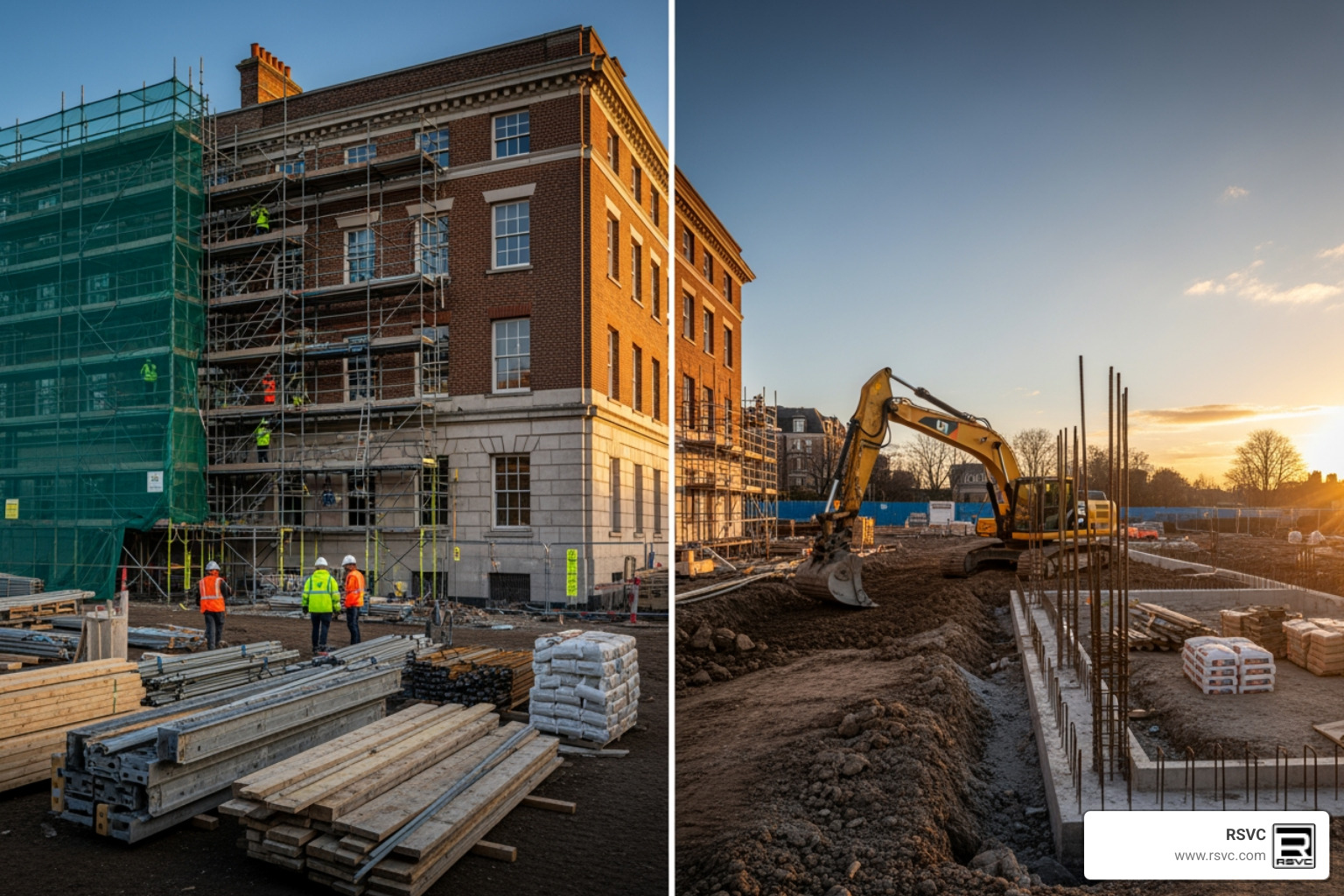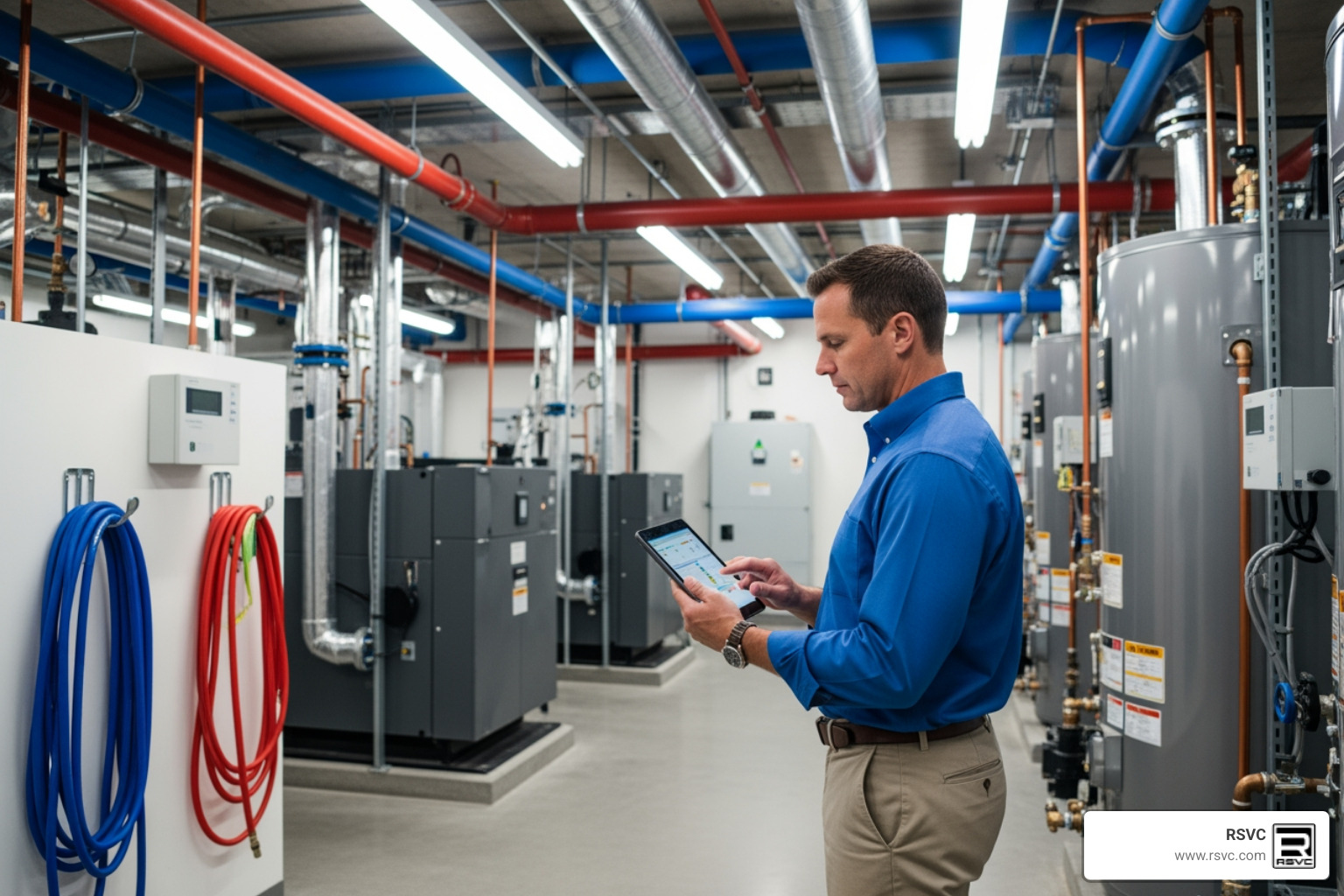When planning a commercial facility, whether it’s a ground-up build or a major renovation, the decisions made during the early stages can have a lasting impact on the building’s performance and lifespan. From the foundation and structural supports to plumbing, electrical systems, and HVAC, every piece of infrastructure plays a critical role in ensuring the facility remains safe, efficient, and resilient for years to come.
Key infrastructure choices aren’t just about meeting building codes—they affect operational efficiency, maintenance costs, and even the customer experience. Selecting durable materials, planning for future upgrades, and coordinating systems properly can prevent costly repairs, minimize downtime, and protect your investment, ensuring your facility continues to support your business goals long into the future.
With the average U.S. commercial building being 54 years old and nearly half constructed before 1980, many facility managers oversee aging properties. This reality presents a constant challenge: electrical systems unable to handle modern power loads, HVAC units past their 15-20 year lifespan, and plumbing that causes hidden leaks. These are not minor issues but significant safety hazards and financial drains.
Every facility manager must decide whether to patch problems, invest in comprehensive upgrades, or rebuild entirely. The stakes are high, as reactive maintenance costs 3-4 times more than preventive care, and deferred maintenance grows at 7% annually. With construction costs rising 30% since 2020, these decisions are more consequential than ever.
This guide outlines the warning signs of aging infrastructure, the financial implications of different strategies, and the framework needed to protect your investment for decades.
What may seem like minor annoyances—flickering lights, a musty smell, or frequent equipment hiccups—are often your facility’s way of signaling underlying problems. Before making key infrastructure decisions, it’s crucial to understand these warning signs. Flickering lights can indicate overloaded or faulty wiring, repeated equipment failures often point to systems nearing the end of their life, and a persistent musty odor may signal hidden moisture that could lead to mold or structural damage. Recognizing these signals early helps you make smarter, more proactive decisions that protect both your investment and your operations.

These are not quirks of an old building; they are critical alerts to potential safety hazards and operational disruptions. When an HVAC system fails or the power goes out, operations grind to a halt. More seriously, aging infrastructure poses genuine safety risks, including electrical fires from overloaded circuits, structural failures from water damage, and exposure to hazardous materials like asbestos or lead-based paint.
Water damage is a primary cause of expensive structural problems. In fact, over 50% of structural weaknesses in surveyed buildings trace back to inadequate drainage. When water pools around a foundation, it can cause settlement and other issues that account for 20-25% of structural problems in commercial properties. Why Foundation Waterproofing is Essential for Every Property is a critical consideration for preventing these issues.
Outdated plumbing systems are another culprit, with corroding pipes causing leaks behind walls that compromise insulation, drywall, and electrical wiring, leading to mold growth and poor indoor air quality. Commercial Construction Plumbing must be addressed in older buildings to prevent such damage.
Environmental hazards also lurk in older facilities. Asbestos, once a common building material, and lead-based paint demand careful assessment and professional remediation during any renovation project to ensure occupant safety.
Buildings constructed decades ago were not designed for the massive power demands of today's technology-driven workplaces. This mismatch creates significant challenges for California businesses.
Electrical systems more than 25 years old often lead to overloaded circuits and overheating wiring. Buildings with aluminum wiring, common in the 1960s and 1970s, are 55 times more likely to have fire-hazard conditions. Electrical hazards in older buildings are a serious concern, as electrical faults cause nearly 15% of fire incidents in commercial buildings.
Beyond safety, frequent downtime from power outages hurts productivity and revenue. Similarly, inefficient HVAC systems, which typically last 15 to 20 years, create uncomfortable working conditions and lead to rising energy bills, draining your operating budget.
Addressing these issues is paramount. As detailed in Electrical and Plumbing Considerations in Commercial Construction Projects, facility managers must balance the need for energy efficiency, modern power capacity, and cost-effectiveness to ensure occupant well-being. Ignoring these red flags is a decision that only gets more expensive over time.

Once you've identified the warning signs, you face a critical moment. The** infrastructure decisions move from theory to practice, shaping your budget and performance for years. This isn't just about fixing or replacing; it's a strategic choice between a short-term patch and a long-term solution.
The numbers are clear: reactive maintenance costs 3-4 times more than preventive care. Waiting for a system to break means paying a premium for emergency response, downtime, and collateral damage. Furthermore, deferred maintenance doesn't wait; it grows at roughly 7% annually, making problems more expensive the longer you postpone them.
This is where the total cost of ownership becomes a crucial concept. A new HVAC system may have a high upfront cost, but the long-term savings in energy, repairs, and reliability often justify the investment. As highlighted in guides to Commercial Building Repairs, proactive investments can save multiples of their initial cost over time. Proactive maintenance reduces repair costs by 30-50%, extends equipment life, and mitigates hazards, while a reactive approach leads to higher expenses, increased risks, and unplanned disruptions.
Deciding whether to renovate or start fresh is a central challenge. There's no single right answer, but several factors guide the decision:
As this Commercial Renovation vs. Remodel: A Comprehensive Comparison Guide explains, renovation offers lower upfront costs and faster timelines. However, it also means working within existing constraints, such as hazardous materials or structural limitations.
New construction offers the freedom to design for optimal efficiency from the ground up. The Benefits of Ground-Up Construction vs. Renovation for Commercial Properties often center on this ability to build it right the first time. While Ground Up Construction requires more capital and time, it results in a facility purpose-built for your needs. Still, Revitalizing Old Buildings: The Power of Commercial Renovation can yield outstanding results if you're working with the building's strengths.
Infrastructure decisions have impacts beyond your property lines. In any California city, major projects require engaging with the community and navigating a complex web of regulations.
At RSVC, we help clients steer these factors to chart a course that balances immediate needs with long-term vision.

Making the decision to act is just the beginning. The most critical infrastructure decisions involve how you manage and maintain your facility moving forward. This requires a shift from reactive firefighting to proactive asset management.
The concept of Design for Maintainability is central to this approach, embedding maintenance considerations into the design phase. This is crucial, as life-cycle costs can account for 80 percent of a building's total expenses. Every dollar invested in maintainable infrastructure pays dividends for decades.
Strategic planning for California facilities means future-proofing your infrastructure by making flexible, adaptable choices. This long-term thinking aligns with sound investing principles, building assets that provide enduring value.
Modern facility condition assessments have moved beyond the clipboard. Today, we harness technology for deeper insights:
In California, sustainability is not just a trend; it's a smart business strategy with a strong financial case. Sustainable infrastructure is no longer optional.
Energy-efficient systems like upgraded HVAC, smart lighting, and high-performance windows deliver immediate benefits. They are smart investments that lower long-term operating costs while reducing your environmental footprint. Water conservation through low-flow fixtures and efficient irrigation is also crucial in California, cutting utility bills and demonstrating environmental responsibility.
Advanced materials like high-performance concrete (HPC) and Fiber-Reinforced Polymers (FRPs) offer superior durability, reducing the frequency of major repairs. While Incorporating Sustainable Practices in Your Commercial Renovation is good for the planet, it also improves property value. Green building certifications like LEED attract quality tenants and command premium rents in California's competitive market.
A solid plan is essential to translate strategy into action. This involves:
In an aging facility, focus on the building's vital systems. Prioritize monitoring your electrical systems, especially if they are over 25 years old, as they pose a fire risk. Your HVAC system is next, as units over 15-20 years old are inefficient and prone to failure. Also, watch plumbing systems for hidden leaks that cause water damage and mold. Finally, regularly inspect your roofing, foundation, and overall structural integrity for signs of failure, and ensure all fire safety systems are tested and functional.
This is a major decision that balances cost, function, and future goals. Start with a detailed cost analysis comparing the long-term total cost of ownership for both options, remembering that reactive repairs cost 3-4 times more than proactive work. Evaluate the remaining useful life of critical systems; if multiple systems are failing, a rebuild may be more economical. Consider your future business needs and whether the current layout can support them. Structural soundness is non-negotiable; significant issues may mandate a rebuild. Finally, weigh location value and the complexities of regulatory compliance under stringent California Building Codes to Consider in Commercial Construction.
Sustainability is a core driver of smart infrastructure decisions, offering significant financial and operational benefits. It directly reduces long-term operating costs through energy and water savings. Sustainable buildings also improve occupant well-being, which boosts productivity. In California, a commitment to sustainability improves brand reputation, increases property value, and ensures you meet strict regulatory requirements.
At RSVC, we've guided countless businesses through this exact decision. We know how overwhelming it can feel when you're weighing all these factors. That's why we focus on understanding your specific goals first, then helping you steer the path that makes the most sense for your situation.
Our team brings together expertise in both new construction and renovation, so we're not pushing you toward one option or another. We're here to give you honest advice based on what we've learned from years of helping California businesses create spaces that truly serve their needs.
Ready to turn your vision into reality? We'd love to help you figure out which path is right for your business and then make it happen with the quality and care you deserve.

